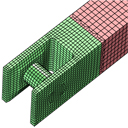Transition Between Two Parts Glued Together
Two parts can be glued together using the block boundary feature.
This assures that the coincident nodes in the two parts are identical.
If the number of elements in one part is half or double the number in
the other part, then a row of hex (quad shell) elements at the interface
are automatically replaced with a row that sews the two parts together to
produce a node for node, edge for edge, and face for face matching
across the parts interface.
The transition is also automatically formed if the ratio between the parts
is 1:3.
The transition layer can also sew together two parts where the number of
elements differ in both directions along the interface.
The ratio 2:4 or 1:3 is required
in both directions. The ratios do not have to be the same in both directions.
The example below is a 2:4 in two directions.
Multiple Layers Forming Locally Dense Meshs
These transitions can be layered to radically change the mesh density. The example below has three transitions in two directions with a transition scale factor of 12 in each direction.
Irregular Region Filled using Transitions
Frequently, a part is needed that cannot be meshed with a simple block. If this part is in the interior where surrounding parts dictate the number of elements along the boundary of the part, a complex solution is needed. Several parts are constructed with transitions between them. Below is an example with three parts and three wedge columns. The wedges are easily formed by collapsing a face of a hex element.
Use Transitions with Caution
All boundary conditions, initial conditions, and properties are maintained along when the trasitional element substitution is made. This feature can be abused because, by the very nature of these transitions, the quality is limited. In particular, the angles can be severe and can introduce numerical errors in the simulation. It is best to place these transitions in areas of low interest.

![]() Home Page
Home Page

Questions, comments, suggestions

Copyright © 1996-2013 XYZ Scientific Applications, Inc. All rights reserved.



